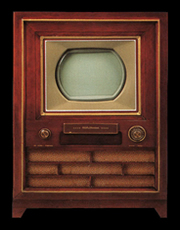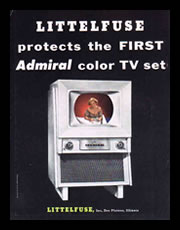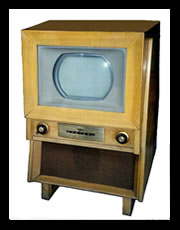
RCA's first color TV was model number CT-100

Littlefuse Advertisement showing the "First Admiral color TV set

Bruce Buchanan's 1954 Admiral Color Television
Color Television
Field Sequential System Color TV
This was the first concept of color TV, and it involved the use of three color (RGB) filters before electron gun scanning. The camera tube uses the raster scan technique, which operates faster than a rotating RGB filter. When the red filter position comes between the camera tube and the lens, the camera tube scans the entire picture. Then, the filter rotates to the next color, and the same process is repeated.
RCA Dot Sequential Color System
In the Dot Sequential Color System, the system is quite a bit more complicated than the Field Sequential System.
The differences are:
- The Field Sequential System reads all of the data before changing to the next color filter.
- The Dot Sequential Color System samples each the data of each color and make the series of data RGB follow together.
A color TV monitor uses three RGB CRT monitors to produce natural color TV. Instead of using three color filters, a color TV monitor uses three CRTs, each with a different filter. These transmit the signals in series while the receiver uses three CRTs and three color electron guns to combine the three monitors into one color image on the screen.
Did you know?
In 1996, Digital satellite dishes that were only 18 inches in diameter hit the market. They became the biggest selling electronic item in history next to the VCR.
